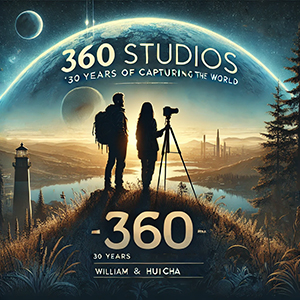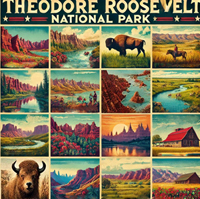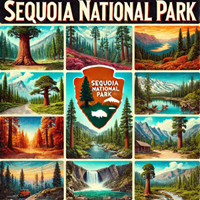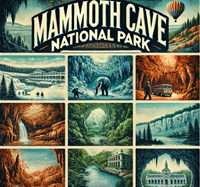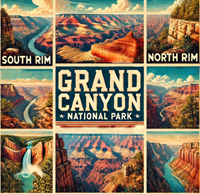

Embark on a journey curated by seasoned explorers William and Hui Cha Stanek, who have spent decades immersing themselves in the diverse landscapes of North America. These itineraries are more than just travel plans - they are thoughtfully crafted adventures designed to help you connect with the natural world, discover hidden gems, and create lasting memories.
National Parks Index | US Itineraries Index | American Roadtrips Index

Bring home a Bugville Critters book and watch as your child's love for reading and learning grows with every page. Hand-painted illustrations bring the heartwarming stories to life. Ask your librarian to add Bugville Critters to the library's digital collection today!
Discover William Stanek's Exclusive Art Collection
Explore and purchase the stunning art featured on this site. Own a piece of William Stanek's unique and captivating artwork today!
(January 27, 2025) Ultimate 5-Day Adventure Through Indiana Dunes, Mammoth Cave, and Gateway Arch
Introduction: Exploring the Heart of America's Natural and Historical Wonders
The Midwest is often seen as the heartland of America, a region rich in natural beauty and historical significance. Our five-day adventure through Indiana Dunes National Park, Mammoth Cave National Park, and Gateway Arch National Park offers a unique journey that blends the beauty of pristine beaches and towering sand dunes, the mystery of the world's longest cave system, and the grandeur of an iconic monument to westward expansion.
Each destination provides a different experience: Indiana Dunes, with its diverse ecosystems and stunning views of Lake Michigan; Mammoth Cave, a subterranean wonder that invites exploration of its ancient passageways; and Gateway Arch, a towering symbol of human ingenuity and the spirit of adventure. This itinerary is designed to help you make the most of these parks, combining scenic hikes, underground explorations, and historical insights.
Join us as we embark on an unforgettable journey through the heart of America's natural and historical wonders.
Day 1: Indiana Dunes National Park – The Shores of Lake Michigan
Morning: Sunrise at West Beach
Overview
Start your adventure with an early morning visit to West Beach, one of the most beautiful and accessible spots in Indiana Dunes National Park. The beach offers stunning views of Lake Michigan and the Chicago skyline on the horizon, making it a perfect location for a sunrise walk along the shore.
Tips from William
"Arriving at West Beach at sunrise provides an opportunity to capture the soft morning light reflecting off the water and sand. Bring a wide-angle lens to capture the expansive views of the lake and shoreline. The light at this time of day is perfect for creating serene and atmospheric images."
Insights from Hui Cha
"Walking along West Beach in the early morning is a peaceful experience. The sound of the waves lapping against the shore, the cool breeze off the lake, and the sight of the sun rising over the water create a sense of calm and connection to nature. It's a beautiful way to start your day."
How to Access West Beach
Directions:
- From Gary, Indiana, take US-12 west to the West Beach entrance. The parking area is a short walk from the beach.
Beach Details:
- Location: West Beach, Indiana Dunes National Park
- Difficulty: Easy
Photography Tips: For the best shots at West Beach, focus on capturing the reflections in the water and the soft light on the sand. A wide-angle lens will help you capture the expansive views, while a tripod can stabilize your camera for long exposure shots of the waves.
Alternative Activity: If a sunrise walk along the beach is too early, consider visiting West Beach later in the morning for a leisurely stroll and birdwatching. The area is home to a variety of bird species, especially during migration seasons.
Mid-Morning: Hiking the Dune Succession Trail
Overview
After your sunrise walk, take a hike on the Dune Succession Trail, a loop trail that offers stunning views of the dunes, forest, and Lake Michigan. The trail includes several staircases that lead to high points on the dunes, where you can enjoy panoramic views of the park.
Tips from William
"The Dune Succession Trail is perfect for landscape photography. Bring a wide-angle lens to capture the expansive views of the dunes and lake, and a telephoto lens to zoom in on the details of the plants and wildlife. The best light for photography is in the mid-morning when the sun is high enough to illuminate the dunes but not too harsh."
Insights from Hui Cha
"Hiking the Dune Succession Trail is a journey through the different stages of dune development. The sight of the towering dunes, the sound of the wind in the grass, and the views of the lake create a sense of wonder and connection to the natural world."
How to Access the Dune Succession Trail
Directions:
- The Dune Succession Trail begins at the West Beach parking area. The trail is well-marked and includes several staircases that lead to the high points on the dunes.
Trail Details:
- Trail Length: 1.1 miles loop
- Elevation Gain: 250 feet
- Difficulty: Moderate (due to stairs)
Photography Tips: For the best shots along the Dune Succession Trail, focus on capturing the patterns in the sand and the contrast between the dunes and the lake. A tripod can help stabilize your camera for sharp images, especially in the low light under the forest canopy.
Alternative Activity: If the stairs on the Dune Succession Trail are too challenging, consider exploring the nearby Cowles Bog Trail, a 4.7-mile loop that offers beautiful views of wetlands, dunes, and the lake with less elevation change.
Afternoon: Exploring the Bailly Homestead and Chellberg Farm
Overview
In the afternoon, visit the historic Bailly Homestead and Chellberg Farm, two sites that offer a glimpse into the area's early European settlement. The Bailly Homestead, established in the early 19th century, was a fur trading post, while Chellberg Farm represents a Swedish immigrant farmstead from the late 19th century.
Tips from William
"Bailly Homestead and Chellberg Farm offer unique opportunities for historic and landscape photography. Bring a wide-angle lens to capture the homestead and farm buildings in their natural settings, and a telephoto lens for close-up shots of the details. The best light for photography is in the late afternoon when the sun is low in the sky and the shadows are long."
Insights from Hui Cha
"Exploring Bailly Homestead and Chellberg Farm is like stepping back in time. The sight of the old buildings, the sound of the wind in the trees, and the beauty of the surrounding landscape create a sense of connection to the past and the history of the region."
How to Access Bailly Homestead and Chellberg Farm
Directions:
- From West Beach, take US-12 east to Mineral Springs Road. Follow signs for Bailly Homestead and Chellberg Farm. The sites are within walking distance of each other.
Site Details:
- Location: Bailly Homestead and Chellberg Farm, Indiana Dunes National Park
- Difficulty: Easy
Photography Tips: For the best shots at Bailly Homestead and Chellberg Farm, focus on capturing the play of light and shadow on the buildings and surrounding landscape. Use a wide-angle lens to capture the full scene, and switch to a telephoto lens to zoom in on the details of the architecture and surrounding nature.
Alternative Activity: If exploring the historic sites sounds too strenuous, consider taking a leisurely walk along the Little Calumet River Trail, which offers beautiful views of the river and the surrounding forest.
Evening: Sunset at Mount Baldy
Overview
End your first day at Indiana Dunes with a sunset at Mount Baldy, the park's most famous dune. The towering sand dune offers stunning views of Lake Michigan and the surrounding landscape, making it a perfect spot to watch the sun dip below the horizon.
Tips from William
"Mount Baldy is a fantastic spot for sunset photography, with wide, sweeping views of the lake and dunes. Set up your tripod well before sunset to find the best angle, and use a wide-angle lens to capture the full scene. A graduated neutral density filter will help balance the exposure between the bright sky and the darker landscape."
Insights from Hui Cha
"Watching the sunset from Mount Baldy is a peaceful and beautiful experience. The colors of the sky, the stillness of the lake, and the sound of the wind in the dunes create a sense of calm and connection to nature. It's a perfect way to end the day."
How to Access Mount Baldy
Directions:
- From Bailly Homestead, take US-12 east to the Mount Baldy parking area. The dune is a short walk from the parking lot.
Viewpoint Details:
- Location: Mount Baldy, Indiana Dunes National Park
- Elevation Gain: Minimal
- Difficulty: Easy
Photography Tips: For a stunning sunset shot, position yourself on the western side of the dune to capture the last light of the day as it illuminates the sand and lake. Use a small aperture (f/16 or smaller) to keep the entire scene in focus, and experiment with different shutter speeds to capture the changing light.
Alternative Activity: If hiking to the top of Mount Baldy sounds too challenging, consider watching the sunset from the nearby Lake View Beach, which offers equally beautiful views of the lake and surrounding dunes.
Day 2: Mammoth Cave National Park – Exploring the Subterranean World
Morning: Historic Tour of Mammoth Cave
Overview
Begin your second day with a guided Historic Tour of Mammoth Cave, the world's longest known cave system. This tour takes you through some of the cave's most famous passageways, including the Rotunda, Gothic Avenue, and Mammoth Dome. Along the way, you'll learn about the cave's rich history, geology, and the people who have explored and studied it over the centuries.
Tips from William
"Mammoth Cave is a challenging but rewarding environment for photography. Bring a tripod and a camera with good low-light capabilities to capture the details of the cave formations and passageways. The dim lighting and tight spaces make it important to use slow shutter speeds and a small aperture to keep the entire scene in focus."
Insights from Hui Cha
"Exploring Mammoth Cave is a journey into a world unlike any other. The cool, damp air, the sound of water dripping from the cave ceiling, and the sight of the massive underground chambers create a sense of wonder and connection to the natural world. Dress warmly, as the cave is cool year-round, and bring a flashlight to help navigate the darker sections of the tour."
How to Access Mammoth Cave
Directions:
- From Bowling Green, Kentucky, take I-65 north to the Mammoth Cave exit. Follow signs to the visitor center, where the Historic Tour begins.
Tour Details:
- Location: Mammoth Cave National Park, KY
- Tour Length: 2 hours, 2 miles round-trip
- Difficulty: Moderate (due to stairs and tight spaces)
Photography Tips: For the best shots inside Mammoth Cave, focus on capturing the texture and details of the cave formations. A tripod is essential for stabilizing your camera in the low light, and a wide-angle lens will help you capture the scale of the underground chambers.
Alternative Activity: If the Historic Tour sounds too challenging, consider taking the Frozen Niagara Tour, a shorter and less strenuous tour that offers beautiful views of cave formations such as flowstone and stalactites.
Mid-Morning: Hiking the Cedar Sink Trail
Overview
After your cave tour, take a hike on the Cedar Sink Trail, a short but scenic trail that leads to a large sinkhole surrounded by lush forest. The trail offers beautiful views of the park's karst landscape, with its limestone cliffs, caves, and underground rivers.
Tips from William
"The Cedar Sink Trail is perfect for landscape and macro photography. Bring a wide-angle lens to capture the expansive views of the sinkhole and surrounding forest, and a macro lens for close-up shots of the plants and fungi along the trail. The best light for photography is in the mid-morning when the sun is high enough to illuminate the sinkhole but not too harsh."
Insights from Hui Cha
"Hiking the Cedar Sink Trail is a journey through the heart of Mammoth Cave's unique landscape. The sight of the sinkhole, the sound of the birds in the trees, and the beauty of the forest create a sense of peace and connection to nature."
How to Access the Cedar Sink Trail
Directions:
- From the Mammoth Cave Visitor Center, take Brownsville Road west to the Cedar Sink Trailhead. The trail is well-marked and easy to follow.
Trail Details:
- Trail Length: 1.2 miles round-trip
- Elevation Gain: 300 feet
- Difficulty: Moderate
Photography Tips: For the best shots along the Cedar Sink Trail, focus on capturing the contrast between the limestone cliffs and the lush greenery. A tripod can help stabilize your camera for sharp images, especially in the low light under the forest canopy.
Alternative Activity: If the hike to Cedar Sink is too challenging, consider exploring the nearby Green River Bluffs Trail, a 1.3-mile loop that offers beautiful views of the Green River and the surrounding forest with less elevation change.
Afternoon: Exploring the Green River by Kayak
Overview
In the afternoon, explore the Green River by kayak, one of the best ways to experience the natural beauty of Mammoth Cave National Park. Paddling along the river, you can observe the park's diverse wildlife, including deer, beavers, and a variety of bird species. The calm waters and scenic surroundings make for a peaceful and enjoyable paddle.
Tips from William
"Kayaking on the Green River offers unique photo opportunities, with beautiful views of the river, cliffs, and forest. Bring a waterproof camera or a GoPro to capture the reflections in the water and the details of the plants and animals. The best light for photography is in the late afternoon when the sun is low in the sky and the shadows are long."
Insights from Hui Cha
"Kayaking on the Green River is a peaceful and immersive way to experience the park. The stillness of the water, the sight of the rocky cliffs, and the beauty of the surrounding forest create a sense of connection to nature and solitude."
How to Access the Green River
Directions:
- Kayak rentals and guided tours are available at several outfitters near the park. The river is easily accessible from the Green River Ferry, located within the park.
Kayaking Details:
- Location: Green River, Mammoth Cave National Park
- Difficulty: Easy to Moderate
Photography Tips: For the best shots while kayaking, focus on capturing the reflections in the water and the details of the riverbanks. A wide-angle lens will help you capture the expansive views, while a telephoto lens is ideal for zooming in on wildlife.
Alternative Activity: If kayaking sounds too strenuous, consider taking a leisurely boat tour of the Green River. The tour provides informative insights into the park's natural and cultural history while allowing you to enjoy the beauty of the river without the effort of paddling.
Evening: Sunset at Sunset Point
Overview
End your day at Mammoth Cave with a sunset at Sunset Point, a scenic overlook that offers stunning views of the Green River and the surrounding landscape. The overlook is a great place to relax and reflect on your day while watching the sun set over the rolling hills of Kentucky.
Tips from William
"Sunset Point is a fantastic spot for sunset photography, with wide, sweeping views of the river and hills. Set up your tripod well before sunset to find the best angle, and use a wide-angle lens to capture the full scene. A graduated neutral density filter will help balance the exposure between the bright sky and the darker landscape."
Insights from Hui Cha
"Watching the sunset from Sunset Point is a peaceful and beautiful experience. The colors of the sky, the stillness of the river, and the sounds of the forest create a sense of calm and connection to nature. It's a perfect way to end the day."
How to Access Sunset Point
Directions:
- From the Mammoth Cave Visitor Center, take the Green River Ferry Road to the Sunset Point Trailhead. The overlook is a short walk from the parking area.
Viewpoint Details:
- Location: Sunset Point, Mammoth Cave National Park
- Elevation Gain: Minimal
- Difficulty: Easy
Photography Tips: For a stunning sunset shot, position yourself on the western side of the overlook to capture the last light of the day as it illuminates the river and hills. Use a small aperture (f/16 or smaller) to keep the entire scene in focus, and experiment with different shutter speeds to capture the changing light.
Alternative Activity: If the walk to Sunset Point sounds too challenging, consider watching the sunset from the Green River Ferry, where you can enjoy the views from the comfort of your car or a nearby bench.
Day 3: Gateway Arch National Park – St. Louis, Missouri
Morning: Sunrise at the Gateway Arch
Overview
Begin your third day with a sunrise visit to the Gateway Arch, the iconic monument that symbolizes the westward expansion of the United States. The Arch, standing 630 feet tall, offers stunning views of the Mississippi River and the St. Louis skyline. Watching the sunrise from the base of the Arch is a breathtaking experience that captures the grandeur of this American landmark.
Tips from William
"The Gateway Arch is a fantastic subject for sunrise photography. Bring a wide-angle lens to capture the full height of the Arch and the surrounding landscape. The best light for photography is in the early morning when the sun is low in the sky and the shadows are long."
Insights from Hui Cha
"Watching the sunrise at the Gateway Arch is a powerful and inspiring experience. The sight of the sun rising behind the Arch, casting a warm glow over the river and the city, creates a sense of awe and connection to the history of this place. It's a beautiful way to start your day."
How to Access the Gateway Arch
Directions:
- From downtown St. Louis, take Memorial Drive to the Gateway Arch National Park. The Arch is easily accessible from several points in the city, with parking available nearby.
Viewpoint Details:
- Location: Gateway Arch, St. Louis, MO
- Elevation Gain: None
- Difficulty: Easy
Photography Tips: For the best shots of the Gateway Arch at sunrise, position yourself on the eastern side of the Arch to capture the sun rising behind it. Use a small aperture (f/16 or smaller) to keep the entire scene in focus, and experiment with different compositions to highlight the Arch against the changing colors of the sky.
Alternative Activity: If a sunrise visit to the Gateway Arch sounds too early, consider visiting later in the morning when the light is still good for photography, and you can take a tram ride to the top for panoramic views of the city and river.
Mid-Morning: Exploring the Museum at the Gateway Arch
Overview
After your sunrise visit, take some time to explore the Museum at the Gateway Arch, located at the base of the monument. The museum offers exhibits on the history of the westward expansion, the construction of the Arch, and the city of St. Louis. It's a fascinating look at the history and significance of this iconic landmark.
Tips from William
"The museum offers unique opportunities for architectural and documentary photography. Bring a wide-angle lens to capture the exhibits and the interior of the museum, and a telephoto lens for close-up shots of the artifacts and displays. The best light for photography is in the mid-morning when the museum is less crowded."
Insights from Hui Cha
"Exploring the Museum at the Gateway Arch is a fascinating journey through American history. The exhibits on the Lewis and Clark expedition, the pioneers who settled the West, and the construction of the Arch create a sense of connection to the past and the spirit of adventure that shaped this country."
How to Access the Museum at the Gateway Arch
Directions:
- The museum is located at the base of the Gateway Arch and is easily accessible from the Arch grounds. Admission to the museum is included with your Arch ticket.
Museum Details:
- Location: Gateway Arch, St. Louis, MO
- Difficulty: Easy
Photography Tips: For the best shots inside the museum, focus on capturing the details of the exhibits and the play of light and shadow in the interior spaces. A tripod can help stabilize your camera for sharp images, especially in low-light conditions.
Alternative Activity: If the museum sounds too crowded, consider taking a walk along the Mississippi Riverfront, which offers beautiful views of the river, the Arch, and the historic riverboats.
Afternoon: Riverboat Cruise on the Mississippi River
Overview
In the afternoon, take a riverboat cruise on the Mississippi River, a relaxing way to experience the beauty and history of St. Louis. The cruise offers stunning views of the Gateway Arch, the St. Louis skyline, and the river, with informative commentary on the city's history and landmarks.
Tips from William
"A riverboat cruise on the Mississippi offers unique photo opportunities, with beautiful views of the Arch, the skyline, and the river. Bring a telephoto lens to capture the details of the city and a wide-angle lens for shots of the river and surrounding landscape. The best light for photography is in the late afternoon when the sun is low in the sky and the shadows are long."
Insights from Hui Cha
"Taking a riverboat cruise on the Mississippi is a peaceful and enjoyable way to experience St. Louis. The sight of the Arch from the water, the sound of the boat gliding through the river, and the beauty of the city create a sense of connection to the history and culture of this place."
How to Access the Riverboat Cruise
Directions:
- Riverboat cruises depart from the Gateway Arch Riverfront, located at the base of the Arch. Tickets can be purchased at the Arch or online.
Cruise Details:
- Location: Mississippi River, St. Louis, MO
- Duration: 1 hour
- Difficulty: Easy
Photography Tips: For the best shots on the riverboat cruise, focus on capturing the play of light and shadow on the Arch and skyline. A telephoto lens will help you zoom in on the details of the city, while a wide-angle lens is ideal for capturing the expansive views of the river and surrounding landscape.
Alternative Activity: If a riverboat cruise sounds too crowded, consider taking a walk along the Gateway Arch grounds, which offer beautiful views of the Arch and the city from different perspectives.
Evening: Sunset at the Old Courthouse
Overview
End your day in St. Louis with a sunset visit to the Old Courthouse, a historic building that played a key role in the Dred Scott case, a pivotal moment in the history of civil rights in America. The Courthouse offers stunning views of the Gateway Arch and the city skyline, making it a perfect spot to watch the sun set over St. Louis.
Tips from William
"The Old Courthouse is a fantastic subject for sunset photography, with beautiful views of the Arch and the city skyline. Set up your tripod well before sunset to find the best angle, and use a wide-angle lens to capture the full scene. A graduated neutral density filter will help balance the exposure between the bright sky and the darker landscape."
Insights from Hui Cha
"Watching the sunset at the Old Courthouse is a peaceful and reflective experience. The sight of the Arch framed by the Courthouse, the colors of the sky, and the history of this place create a sense of connection to the past and the ongoing struggle for justice and equality in America."
How to Access the Old Courthouse
Directions:
- The Old Courthouse is located just east of the Gateway Arch and is easily accessible from the Arch grounds. Parking is available nearby.
Viewpoint Details:
- Location: Old Courthouse, St. Louis, MO
- Elevation Gain: None
- Difficulty: Easy
Photography Tips: For a stunning sunset shot, position yourself on the western side of the Courthouse to capture the Arch and skyline in the golden hour light. Use a small aperture (f/16 or smaller) to keep the entire scene in focus, and experiment with different compositions to highlight the architectural details of the Courthouse against the changing colors of the sky.
Alternative Activity: If visiting the Old Courthouse sounds too challenging, consider watching the sunset from the nearby Kiener Plaza, which offers equally beautiful views of the Arch and city with the convenience of seating and green space.
Day 4: Indiana Dunes National Park – A Return to the Lakeshore
Morning: Birdwatching at the Great Marsh Trail
Overview
Begin your fourth day with a morning of birdwatching at the Great Marsh Trail, one of the best spots in Indiana Dunes National Park for observing birds and other wildlife. The trail winds through a large wetland area that is home to a variety of bird species, including herons, egrets, and waterfowl. The early morning is the best time to see the birds as they are most active.
Tips from William
"The Great Marsh Trail is perfect for wildlife photography, especially in the early morning when the light is soft and the birds are active. Bring a telephoto lens to capture the details of the birds and a wide-angle lens for shots of the marsh and surrounding landscape. The best light for photography is in the early morning when the sun is low in the sky and the shadows are minimal."
Insights from Hui Cha
"Birdwatching at the Great Marsh is a peaceful and rewarding experience. The sight of the birds in their natural habitat, the sound of the marsh waking up, and the beauty of the wetland create a sense of connection to the natural world. Dress warmly, as it can be cool in the morning, and bring binoculars for the best views."
How to Access the Great Marsh Trail
Directions:
- The Great Marsh Trail is located off Beverly Drive in the northern part of Indiana Dunes National Park. The trailhead is well-marked and has a small parking area.
Trail Details:
- Trail Length: 1.6 miles round-trip
- Elevation Gain: Minimal
- Difficulty: Easy
Photography Tips: For the best shots along the Great Marsh Trail, focus on capturing the reflections in the water and the details of the birds and vegetation. A tripod can help stabilize your camera for sharp images, especially in the low light under the forest canopy.
Alternative Activity: If birdwatching sounds too quiet, consider exploring the nearby Portage Lakefront and Riverwalk, which offers beautiful views of Lake Michigan and the Chicago skyline, as well as opportunities for fishing and photography.
Mid-Morning: Exploring the Indiana Dunes Visitor Center
Overview
After your morning of birdwatching, take some time to explore the Indiana Dunes Visitor Center, located near the entrance to the park. The Visitor Center offers exhibits on the park's natural and cultural history, as well as information on the park's many trails and activities. It's a great place to learn more about the park and plan the rest of your visit.
Tips from William
"The Visitor Center offers unique opportunities for documentary photography, with informative exhibits on the park's history, geology, and wildlife. Bring a wide-angle lens to capture the exhibits and the interior of the center, and a telephoto lens for close-up shots of the displays and artifacts. The best light for photography is in the mid-morning when the center is less crowded."
Insights from Hui Cha
"Exploring the Indiana Dunes Visitor Center is a fascinating journey through the park's natural and cultural history. The exhibits on the formation of the dunes, the plants and animals that call the park home, and the history of the area create a sense of connection to the land and the people who have lived here."
How to Access the Indiana Dunes Visitor Center
Directions:
- The Visitor Center is located off Indiana State Road 49, near the entrance to the park. The center is easily accessible from several points in the area, with parking available nearby.
Visitor Center Details:
- Location: Indiana Dunes National Park, IN
- Difficulty: Easy
Photography Tips: For the best shots inside the Visitor Center, focus on capturing the details of the exhibits and the play of light and shadow in the interior spaces. A tripod can help stabilize your camera for sharp images, especially in low-light conditions.
Alternative Activity: If exploring the Visitor Center sounds too quiet, consider taking a short hike on the nearby Calumet Dunes Trail, a 1.1-mile loop that offers beautiful views of the dunes and surrounding forest.
Afternoon: Hiking the Three Dunes Challenge
Overview
In the afternoon, take on the Three Dunes Challenge, a popular hike that takes you up and over the park's three tallest dunes: Mount Tom, Mount Holden, and Mount Jackson. The hike is challenging but rewarding, with stunning views of Lake Michigan, the surrounding dunes, and the Chicago skyline on a clear day.
Tips from William
"The Three Dunes Challenge is perfect for landscape and action photography. Bring a wide-angle lens to capture the expansive views from the top of the dunes, and a telephoto lens for close-up shots of the plants and wildlife along the trail. The best light for photography is in the late afternoon when the sun is low in the sky and the shadows are long."
Insights from Hui Cha
"Hiking the Three Dunes Challenge is a test of endurance and a journey through some of the most beautiful landscapes in the park. The sight of the lake from the top of the dunes, the sound of the wind in the sand, and the challenge of the climb create a sense of achievement and connection to nature."
How to Access the Three Dunes Challenge
Directions:
- The Three Dunes Challenge begins at the Indiana Dunes State Park Nature Center, located near the eastern edge of the national park. The trail is well-marked and includes several steep climbs and descents.
Trail Details:
- Trail Length: 1.5 miles loop
- Elevation Gain: 550 feet
- Difficulty: Strenuous
Photography Tips: For the best shots along the Three Dunes Challenge, focus on capturing the patterns in the sand and the contrast between the dunes and the lake. A tripod can help stabilize your camera for sharp images, especially in the low light under the forest canopy.
Alternative Activity: If the Three Dunes Challenge sounds too strenuous, consider exploring the nearby Heron Rookery Trail, a 3.3-mile out-and-back hike that offers beautiful views of the Little Calumet River and the surrounding forest.
Evening: Sunset at the Century of Progress Homes
Overview
End your day with a sunset visit to the Century of Progress Homes, a collection of historic homes built for the 1933 Chicago World's Fair and later moved to the Indiana Dunes. The homes, located along the shore of Lake Michigan, offer a glimpse into the architectural innovations of the early 20th century and are a fascinating part of the park's history.
Tips from William
"The Century of Progress Homes are a fantastic subject for architectural and sunset photography. Bring a wide-angle lens to capture the homes in their natural setting, and a telephoto lens for close-up shots of the details. The best light for photography is in the late evening when the sun is low in the sky and the shadows are long."
Insights from Hui Cha
"Watching the sunset at the Century of Progress Homes is a peaceful and reflective experience. The sight of the sun setting over the lake, the colors of the sky, and the history of these unique homes create a sense of connection to the past and the beauty of the place."
How to Access the Century of Progress Homes
Directions:
- The Century of Progress Homes are located along Lake Front Drive in the town of Beverly Shores, just east of the Indiana Dunes State Park. Parking is available along the road.
Viewpoint Details:
- Location: Beverly Shores, IN
- Elevation Gain: None
- Difficulty: Easy
Photography Tips: For a stunning sunset shot, position yourself on the western side of the homes to capture the last light of the day as it illuminates the lake and surrounding dunes. Use a small aperture (f/16 or smaller) to keep the entire scene in focus, and experiment with different shutter speeds to capture the changing light.
Alternative Activity: If visiting the Century of Progress Homes sounds too challenging, consider watching the sunset from the nearby Beverly Shores Beach, which offers equally beautiful views of the lake and surrounding dunes.
Day 5: Mammoth Cave National Park – A Return to the Subterranean World
Morning: Wild Cave Tour
Overview
For your final day, take on the Wild Cave Tour, the most adventurous and challenging tour offered at Mammoth Cave National Park. This tour takes you deep into the cave system, where you'll crawl, climb, and squeeze through narrow passageways to explore parts of the cave that few visitors ever see. The Wild Cave Tour is an unforgettable experience for those who love adventure and don't mind getting a little dirty.
Tips from William
"The Wild Cave Tour is perfect for action and documentary photography. Bring a compact camera with good low-light capabilities to capture the details of the cave formations and the adventure of the tour. The tight spaces and low light make it important to use slow shutter speeds and a small aperture to keep the entire scene in focus."
Insights from Hui Cha
"The Wild Cave Tour is an adventure like no other. The thrill of exploring the cave's hidden passageways, the challenge of the climb, and the beauty of the underground world create a sense of achievement and connection to the natural world. Dress in layers, as the cave is cool year-round, and bring gloves and knee pads for protection."
How to Access the Wild Cave Tour
Directions:
- The Wild Cave Tour begins at the Mammoth Cave Visitor Center. The tour lasts approximately six hours and requires advanced reservations.
Tour Details:
- Location: Mammoth Cave National Park, KY
- Tour Length: 6 hours, 5 miles round-trip
- Difficulty: Strenuous
Photography Tips: For the best shots inside Mammoth Cave, focus on capturing the texture and details of the cave formations. A compact camera with a wide aperture is essential for capturing images in the low light, and a headlamp can help illuminate the scene.
Alternative Activity: If the Wild Cave Tour sounds too challenging, consider taking the Domes and Dripstones Tour, a shorter and less strenuous tour that offers beautiful views of cave formations such as flowstone, stalactites, and stalagmites.
Mid-Morning: Hiking the Mammoth Dome Sinkhole Trail
Overview
After your cave tour, take a hike on the Mammoth Dome Sinkhole Trail, a short but scenic trail that leads to one of the park's most impressive sinkholes. The trail offers beautiful views of the park's karst landscape, with its limestone cliffs, caves, and underground rivers.
Tips from William
"The Mammoth Dome Sinkhole Trail is perfect for landscape and macro photography. Bring a wide-angle lens to capture the expansive views of the sinkhole and surrounding forest, and a macro lens for close-up shots of the plants and fungi along the trail. The best light for photography is in the mid-morning when the sun is high enough to illuminate the sinkhole but not too harsh."
Insights from Hui Cha
"Hiking the Mammoth Dome Sinkhole Trail is a journey through the heart of Mammoth Cave's unique landscape. The sight of the sinkhole, the sound of the birds in the trees, and the beauty of the forest create a sense of peace and connection to nature."
How to Access the Mammoth Dome Sinkhole Trail
Directions:
- The Mammoth Dome Sinkhole Trail begins at the Mammoth Cave Visitor Center. The trail is well-marked and easy to follow.
Trail Details:
- Trail Length: 1.5 miles round-trip
- Elevation Gain: 150 feet
- Difficulty: Moderate
Photography Tips: For the best shots along the Mammoth Dome Sinkhole Trail, focus on capturing the contrast between the limestone cliffs and the lush greenery. A tripod can help stabilize your camera for sharp images, especially in the low light under the forest canopy.
Alternative Activity: If the hike to the Mammoth Dome Sinkhole is too challenging, consider exploring the nearby Sloan's Crossing Pond Trail, a 0.4-mile loop that offers beautiful views of a pond and the surrounding forest with less elevation change.
Afternoon: Canoeing on the Green River
Overview
In the afternoon, return to the Green River for a peaceful canoe trip. Paddling along the river, you can observe the park's diverse wildlife, including deer, beavers, and a variety of bird species. The calm waters and scenic surroundings make for a perfect way to end your visit to Mammoth Cave National Park.
Tips from William
"Canoeing on the Green River offers unique photo opportunities, with beautiful views of the river, cliffs, and forest. Bring a waterproof camera or a GoPro to capture the reflections in the water and the details of the plants and animals. The best light for photography is in the late afternoon when the sun is low in the sky and the shadows are long."
Insights from Hui Cha
"Canoeing on the Green River is a peaceful and immersive way to experience the park. The stillness of the water, the sight of the rocky cliffs, and the beauty of the surrounding forest create a sense of connection to nature and solitude."
How to Access the Green River
Directions:
- Canoe rentals and guided tours are available at several outfitters near the park. The river is easily accessible from the Green River Ferry, located within the park.
Canoeing Details:
- Location: Green River, Mammoth Cave National Park
- Difficulty: Easy to Moderate
Photography Tips: For the best shots while canoeing, focus on capturing the reflections in the water and the details of the riverbanks. A wide-angle lens will help you capture the expansive views, while a telephoto lens is ideal for zooming in on wildlife.
Alternative Activity: If canoeing sounds too strenuous, consider taking a leisurely boat tour of the Green River. The tour provides informative insights into the park's natural and cultural history while allowing you to enjoy the beauty of the river without the effort of paddling.
Evening: Sunset at the Historic Entrance
Overview
End your five-day adventure with a sunset at the Historic Entrance to Mammoth Cave, the original entrance to the cave system and a site of historical significance. The entrance is surrounded by lush forest and offers a peaceful and beautiful setting to reflect on your journey.
Tips from William
"The Historic Entrance is a fantastic subject for sunset photography, with beautiful views of the forest and the cave entrance. Set up your tripod well before sunset to find the best angle, and use a wide-angle lens to capture the full scene. A graduated neutral density filter will help balance the exposure between the bright sky and the darker landscape."
Insights from Hui Cha
"Watching the sunset at the Historic Entrance is a peaceful and reflective experience. The sight of the sun setting over the forest, the colors of the sky, and the history of this place create a sense of connection to the past and the natural world. It's a perfect way to end the day."
How to Access the Historic Entrance
Directions:
- The Historic Entrance is located near the Mammoth Cave Visitor Center and is easily accessible from the park's main road. Parking is available nearby.
Viewpoint Details:
- Location: Historic Entrance, Mammoth Cave National Park
- Elevation Gain: Minimal
- Difficulty: Easy
Photography Tips: For a stunning sunset shot, position yourself on the western side of the entrance to capture the last light of the day as it illuminates the forest and cave entrance. Use a small aperture (f/16 or smaller) to keep the entire scene in focus, and experiment with different shutter speeds to capture the changing light.
Alternative Activity: If visiting the Historic Entrance sounds too challenging, consider watching the sunset from the nearby Sand Cave Trail, which offers equally beautiful views of the forest and surrounding landscape.
Conclusion: A Personal Reflection
As the last rays of sunlight faded from the sky and the stars began to emerge, Hui Cha and I stood quietly at the Historic Entrance, reflecting on the incredible journey we had just completed. From the sandy shores of Indiana Dunes to the subterranean wonders of Mammoth Cave and the iconic Gateway Arch, each moment had been a reminder of the rich history and natural beauty of the American heartland.
These parks are more than just places to visit – they are places to connect with the natural world, to find peace and inspiration, and to create memories that will last a lifetime. As we packed up our gear and prepared to leave Mammoth Cave, I felt a deep sense of gratitude for the time we had spent in these wild, untamed places. They had not only shown us the beauty of the land but had also brought us closer to each other and to the world around us.
Our journey through Indiana Dunes, Mammoth Cave, and Gateway Arch had come to an end, but the experiences we had shared would stay with us forever. And as we drove away from the park, I knew that we would return, drawn back by the promise of new adventures and the chance to explore even deeper into the heart of America's natural and historical wonders.

Step into a world of timeless beauty with our premium, oversized hardcover book - crafted for discerning collectors and anyone who values the power of art. Perfect for your coffee table, it's more than just a book; it's a conversation starter, a window into over 30 years of William's visionary photography.
Your Support Matters
Purchasing artwork from William Stanek's collection not only brings beauty into your life but also helps us continue to share. Thank you for supporting our creative journey!

Support The Lights of Paris by Robert Stanek, William Stanek's pen name! Through vivid historical detail and deeply moving character stories, Robert takes readers on an unforgettable journey through one of history’s most transformative times.

